#Israel Antiquities Authority
Text

What did Jerusalem’s main road look like about 1,500 years ago?
An archaeological excavation conducted by the Israel Antiquities Authority in 2010 near the Old City’s Jaffa Gate brought to life a 1,500 year-old map.
The Madaba Map is an ancient mosaic map that paves the floor of Saint George’s Church in the city of Madaba, Jordan.
The map, created in 6th-7th centuries CE, depicts the Land of Israel during the Byzantine period.
It clearly shows the entrance into Jerusalem from the west via a central single gate that led to the main street of the city.
In the past, the reliability of the map, which, among other buildings, provides the earliest visual description of the Church of the Holy Sepulchre, has been questioned.
The excavation, located near David Street known to tourists as the terraced shopping street exposed for the first time, archaeological evidence of Jerusalem’s central street from about 1,500 years ago.
The salvage excavation, carried out in the wake of infrastructure works undertaken in the area and funded by the Jerusalem Development Authority, gave the archaeologists and the public a rare glimpse into archaeological remains underlying the asphalt and the paving stones.
Familiar with the Madaba Map, Dr. Ofer Sion, Director of the Excavation on behalf of the Israel Antiquities Authority, suspected that the ancient main street underlay the modern road.
"After removing a several archaeological layers, about 4.5m below modern street level, we were excited to discover the large stone slabs, each about one meter long, that were part of the ancient street.
It’s great to see that today’s bustling David Street preserves the route of the Byzantine-period busy street from 1,500 years ago.”
The Madaba Map, whose extant part measures 16x5m, depicts the land of Israel as known to the mosaic artist.
Map encompasses the entire country, with emphasis on Jerusalem and its Christian sites.
It shows that many churches were first constructed in Jerusalem during this period, when city underwent a religious transformation from a pagan to a Christian city.
The churches can be identified by their red tiled roofs illustrated on the map.
© Israel Antiquities Authority
#Madaba Map#Jerusalem#Israel Antiquities Authority#Old City#Jaffa Gate#archaeological excavation#archaeology#ancient mosaic map#mosaic map#Israel#Byzantine period#Saint George’s Church#Church of the Holy Sepulchre#Jerusalem Development Authority#ancient main street#streets#churches#maps#6th century#7th century
7 notes
·
View notes
Text
by John Jeffay
Workers chanced upon the oldest city gate in Israel during excavations to lay a new water pipe.
The stone and mudbrick structure formed part of the fortifications around the ancient city of Tel Erani, in southern Israel, and is believed to be 5,500 years old.
Archeologists have spent many decades exploring the area, but the new discovery indicates the city dates back even earlier than originally thought.
Remains of the gate were found during test drillings to prepare for the laying of a new 11-kilometer water pipeline to the nearby city of Kiryat Gat.

Mekorot, the national water company, has diverted the pipeline as a result of the find, and has been funding a month-long excavation by the Israel Antiquities Authority (IAA).
Before the Tel Erani discovery, the oldest known gate in the country was at Tel Arad, near the southern city of Arad, and estimated to be 5,200 years old.
The Tel Erani gate, or passageway, was built into the city’s heavily fortified walls, which were up to eight meters thick.
12 notes
·
View notes
Text
ARCHEOSCOPERTE / Straordinario ritrovamento in Israele: da una grotta riemergono quattro spade romane (con fodero) e la punta di un giavellotto [FOTO, VIDEO]
#ARCHEOLOGIA #SCOPERTE / Straordinario ritrovamento in #Israele: da una grotta riemergono quattro spade romane (con fodero) e la punta di un giavellotto [FOTO, VIDEO]
Tutti i dettagli su Storie & Archeostorie
Le spade dopo il ritrovamento (foto: ©Israel Antiquities Authority)
Quattro spade romane e la punta di un giavellotto (pilum), tutti risalenti a circa 1900 anni fa, sono stati rinvenuti in perfetto stato di conservazione in Israele a Seliq, all’interno di una grotta nella riserva naturale di En Gedi (o Ein Gedi), un’oasi sulla sponda occidentale del mar Morto. Il ritrovamento, annunciato a…
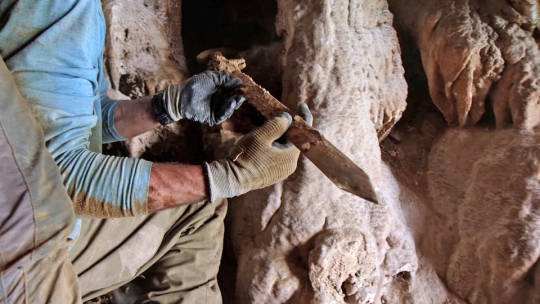
View On WordPress
#Antichità#archeologia#Bar Kokhba#Ein Gedi#età romana#giavellotto#grotta#In evidenza#Israel Antiquities Authority#Israele#notizie#pilum#rivolta di Bar Kokhba#scavi#scavi archeologici#Seliq#spada#spade romane#spatha#Vicino Oriente
4 notes
·
View notes
Text
#israel antiquities authority#israel#archaeology#israel archaeology#jewish history#jumblr#bar kochba revolt#roman era
1 note
·
View note
Text
In yet another example of what happens when people ignore warnings, the Israel Antiquities Authority is now urgently recommending that the regional council and Caeserea Development Corporation secure the funds for the preservation and renovation of the Caeserea aqueduct, after an arch collapsed on Friday morning. Fortunately, nobody was killed, but the result could have been different. The Israel Antiquities Authority had warned of this result for years, to no avail. Now, they note ironically, people will listen.
#caeserea#israel#ancient rome#2000 years#israel antiquities authority#roman#julius caesar#incompetence#recklnessness#artefacts#history#israeli#emperor hadrian#king herod#ancient israel
1 note
·
View note
Text

#ancient#mosaic#floor#art#jewish#symbols#israel antiquities authority#israel museum#jerusalem#israel#middle east#desert#holy land#promised land#biblical archaeology#yerushalayim
0 notes
Text
NUOVI ELEMENTI INDIVIDUATI NEL SISTEMA DIFENSIVO DELLA CITTA' VECCHIA DI GERUSALEMME
Nuovi elementi del sistema di fortificazione della Città Vecchia di Gerusalemme sono stati scoperti negli scavi dell’Israel Antiquities Authority in Sultan Suleiman Street nel corso dei lavori infrastrutturali realizzati dalla Moriah – The Jerusalem Development Corporation.
Elementi delle fortificazioni dell’antica Gerusalemme e un’impronta della mano scolpita nella roccia sono stati scoperti…

View On WordPress
0 notes
Text
Ancient Coins From Maccabean Period Discovered in Judean Desert Cave
Ancient Coins From Maccabean Period Discovered in Judean Desert Cave
By Pesach Benson • 13 December, 2022
Jerusalem, 13 December, 2022 (TPS) — Days ahead of the Hannukah holiday celebrating the Jewish revolt against Greek rule, the Israel Antiquities Authority announced the discovery of a hoard of 2,200-year-old coins from that period.
A rare wooden box containing 15 silver coins dating to the reign of Antiochos IV was discovered in May during an excavation in…

View On WordPress
#2#200-year-old coins discovery#Antiochos Epiphanes IV#Israel Antiquities Authority#Maccabean Revolt
1 note
·
View note
Text


[News Story]
12:55pm More First Temple Finds
It's a banner week for the First Temple archaeology!
An intelligence operation discovered the location of a rare papyrus from the First Temple Period... in Montana.
The woman, who had it framed and hanging on her wall, had received it from her mother, who had received it in 1965 from Joseph Sa‘ad, Curator of the Rockefeller Museum, and Halil Iskander Kandu, a well-known antiquities dealer from Bethlehem, who many years ago sold thousands of Dead Sea scroll fragments.
Papyrus documents that survived from that period, the late seventh or early sixth century BCE, are very rare.
The Muqata
More: Here
17 notes
·
View notes
Text
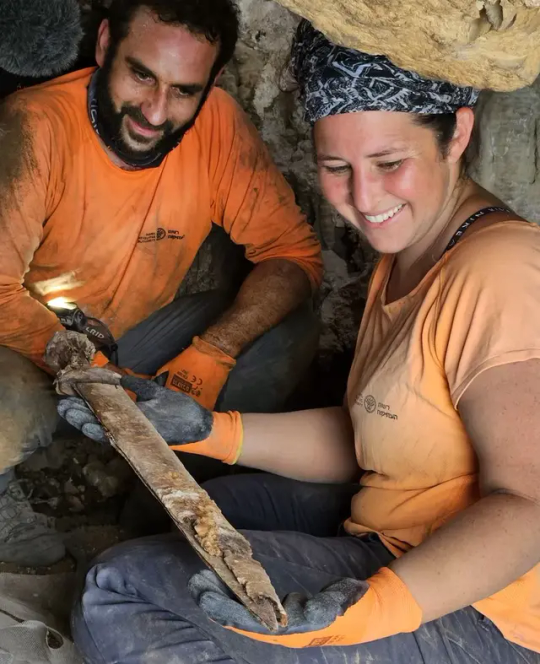

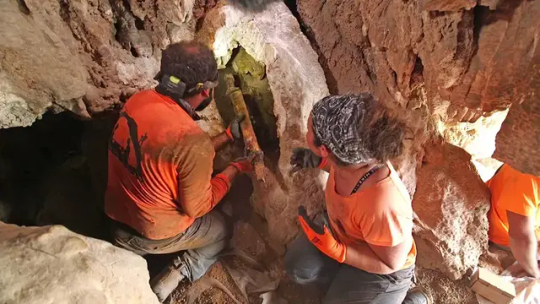
Four 1,900-Year-Old Roman Swords Found in a Judean Desert Cave
Apparently stolen by Jewish rebels, the incredibly well-preserved weapons are ‘an extremely rare find, the likes of which have never been found in Israel’
Archaeologists have discovered four 1,900-year-old Roman swords in a cave in the Judean Desert, which experts believe were captured by the Judean rebels during the Bar Kochba revolt and placed in a narrow crevice in the rock.
“We’re talking about an extremely rare find, the likes of which have never been found in Israel,” Dr. Eitan Klein, one of the directors of the Israel Antiquities Authority’s Judean Desert Survey, said in a video accompanying the announcement of the discovery. “Four swords amazingly preserved, including the fine condition of the metal, the handles, and the scabbards.”
The preliminary article on the swords is published in the volume “New Studies in the Archaeology of the Judean Desert: Collected Papers,” which explores new archaeological finds discovered in the Judean Desert Survey Project. A conference launching the book is taking place Wednesday in Jerusalem.
The four swords were discovered shoved into a small fissure in a cave near Ein Gedi National Park, near the Dead Sea. The cave is already well-known to archaeologists, as it contains a stalactite with a fragmentary ink inscription written in ancient Hebrew script characteristic of the First Temple period.
Recently, Dr. Asaf Gayer of Ariel University, geologist Boaz Langford of Hebrew University, and Israel Antiquities Authority photographer Shai Halevi returned to the cave to photograph the stalactite with multispectral photography, which can decipher additional parts of the inscription not visible to the naked eye. While inside the cave, Gayer spotted an extremely well-preserved Roman pilum — a shafted weapon — in a deep, narrow crack in the rock. He also found pieces of carved wood in an adjacent niche that turned out to be parts of the swords’ scabbards.
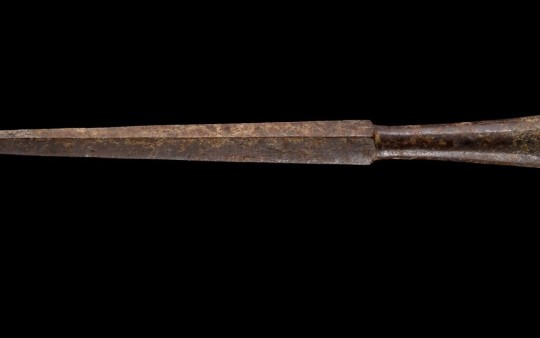
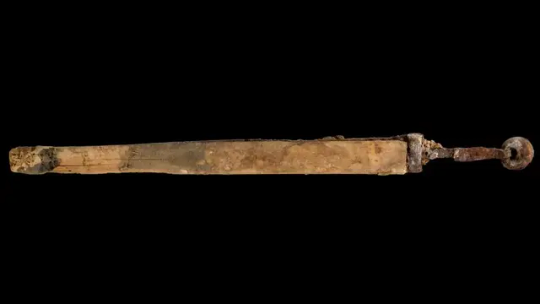



The researchers reported the find to the Israel Antiquities Authority and returned to the site with the Judean Desert Archaeological Survey Team, which is conducting a multi-year comprehensive survey of more than 800 caves in the Judean Desert to find and preserve archaeological remains before they are looted.
It was then that they discovered the four swords, three of which were found with the blades still inside their scabbards. Researchers also found ornate handles made of wood and metal with leather strips nearby. The arid climate in the Judean Desert helps preserve fragile artifacts that might otherwise be lost to the ravages of time, including materials such as leather and wood, which are rarely found in wetter parts of the country.
Three of the swords are Roman spatha swords, with blades 60 to 65 centimeters (23.5 to 25.5 inches) long. The fourth weapon, a ring-pommel sword, is shorter, with a 45-centimeter (18-inch) blade. The swords likely belonged to Roman soldiers and were stolen by Judean rebels who hid them in a cave either for later use or to avoid being caught with them.
“The blades have been preserved so well, they look like they could be picked up and used right now, even 2,000 years after they were forged,” said Langford. “You just realize that you are touching history, because here you are touching a find whose story you know.”
The Bar Kochba revolt, from 132 to 135 CE, also called the Second Jewish Revolt, was a Jewish rebellion against Roman rule in Judea led by rebel leader Simon Bar Kochba. Archaeologists believe the swords were likely hidden in the crevices inside the cave sometime during the revolt, as it was dangerous for Jews to be found with Roman weapons.
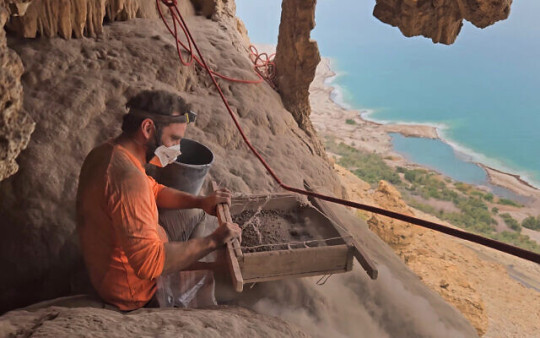
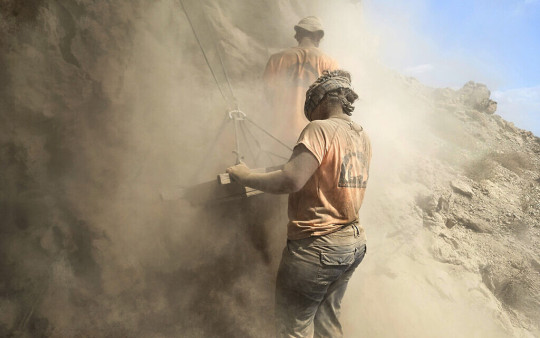
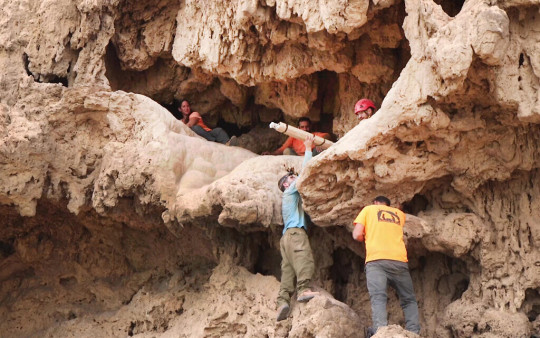
“This is a very rare and unique find on an international level that will shed light on the last moments of the war between the Jewish rebels and the Roman army at the time of the Bar Kochba revolt,” said Klein.
‘A unique time capsule’
The cave survey is being undertaken by the IAA in cooperation with the Archaeology Department of the Civil Administration in Judea and Samaria, and has been funded in part by the Ministry of Jerusalem Affairs and Heritage. Each body allocated about a third of the project budget.
Earlier this year, archaeologists carrying out the Judean Desert cave surveys discovered a rare half-shekel coin minted by the Bar Kochba underground economy.
The cave survey started in 2017 and helped archaeologists discover at least 20 new caves they had not previously known. In 2021, archaeologists announced that one of the caves contained previously undiscovered fragments of the Dead Sea Scrolls, some 60 years after the last pieces of the Dead Sea Scrolls were discovered.

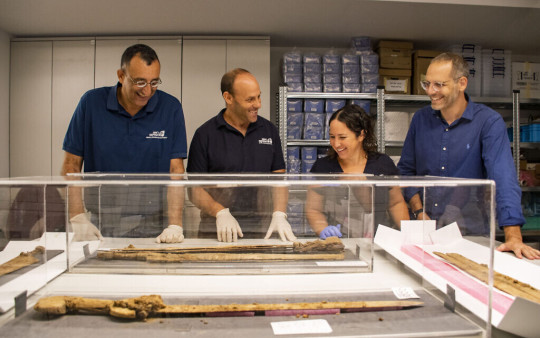
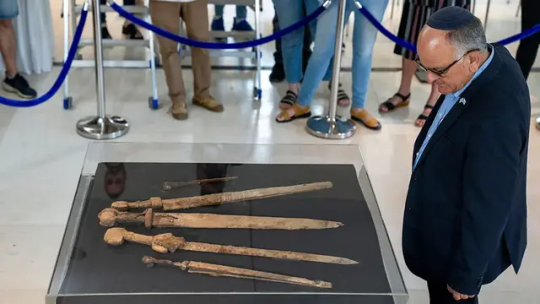
Following the discovery of the swords, archaeologists carried out an extensive excavation of the cave, discovering artifacts from the Chalcolithic period (around 6,000 years ago) and the Roman period (around 2,000 years ago). At the entrance to the cave, researchers found a Bar Kochba bronze coin from the time of the revolt that could help pinpoint the dates when the weapons were hidden.
“This is a dramatic and exciting discovery, touching on a specific moment in time,” said Eli Escusido, director of the Israel Antiquities Authority.
Noting that not all are aware that the dry climatic conditions in the Judean Desert enable the preservation of artifacts that do not survive in other parts of the country, Escusido called the area a “unique time capsule” where it is possible to find “fragments of scrolls, coins from the Jewish Revolt, leather sandals — and now even swords in their scabbards, sharp as if they had only just been hidden away today.”
By Melanie Lidman.
#Four 1900-Year-Old Roman Swords Found in a Judean Desert Cave#Ein Gedi National Park#Judean Desert Survey#Dead Sea#Bar Kochba revolt#roman swords#roman weapons#ancient artifacts#archeology#archeolgst#history#history news#ancient history#ancient culture#ancient civilizations#roman history#roman empire#ancient Israel#Israel history#long reads
349 notes
·
View notes
Text
Excavation site of Pool of Siloam where Jesus cured a blind man to open to public

CNA Newsroom, 7 January 2023
The excavation site of the Pool of Siloam in Jerusalem, the place where Jesus restored sight to a blind man, will be open to the public for the first time.
The Israel Antiquities Authority (IAA), the Israel National Parks Authority, and the City of David Foundation announced the start of excavations that will allow the complete exposure of the Pool of Siloam.
Visitors will be able to see the stage of the excavation of the pool that in the coming months will form part of the tourist route from the City of David to the Western Wall of Jerusalem.
According to the Old Testament, the Pool of Siloam was built during the reign of King Hezekiah (2 Kings 20:20).
The pool is the site of one of the most famous miracles performed by Jesus.
After Jesus smeared the eyes of a blind man with mud and saliva, he sent him to wash in the Pool of Siloam. There the man recovered his sight (John 9:1–7).
In 1980, archaeologists found the first indications of the location of this celebrated biblical site located outside the walls of the Old City of Jerusalem.
However, they had to wait until 2005 to officially confirm their rediscovery.
“According to estimates, the Pool of Siloam went through multiple stages of development, and at the height of its glory, was approximately the size of 5 dunams (1.25 acres) and inlaid with impressive flagstones,” the spokesperson for the IAA explained.
Excavations also revealed that the pool was 225 feet wide and that there were steps on at least three sides of the pool.
The mayor of Jerusalem, Moshe Lion, praised the start of the project.
“The Pool of Siloam in the City of David National Park in Jerusalem is a site of historic, national, and international significance,” he said.
“After many years of anticipation, we will soon merit being able to uncover this important site and make it accessible to the millions of visitors visiting Jerusalem each year,” the mayor said.



#Pool of Siloam#Jerusalem#Jesus#Israel Antiquities Authority (IAA)#Israel National Parks Authority#City of David Foundation#Moshe Lion
1 note
·
View note
Text
Israeli and European archaeologists provide new insight into the mystery of ancient Gaza wine
By JUDY SIEGEL-ITZKOVICH
Published: APRIL 27, 2023 15:22
Grape pips (seeds) that were excavated from a Byzantine monastery in the Negev hint at the origins of the ‘mysterious’ Gaza wine and the history of grapevine cultivation in desert conditions. One of the seeds – probably from a white grape – has been dated to the 8th century and may be the earliest of its kind documented anywhere in the world.
It is thought it could be linked to the sweet white wine - the Gaza wine - that archaeologists have seen references to in historical records, but a lack of evidence of white varieties from the period has until now left uncertainty over its true origins. The wine was produced in the Negev and shipped across the Byzantine Empire, as well as to Germany, France, and Britain, where it is thought to have been enjoyed by royal households.
Researchers at Tel Aviv University (TAU) including Dr. Meirav Meiri of the Steinhardt Museum of Natural History and Israel National Center for Biodiversity Studies; the University of York (England); and the University of Copenhagen (Denmark) used genetic analyses to identify several different grape cultivars that were grown in Negev vineyards including both white and black grapes. Colleagues at the University of Haifa, Bar-Ilan University and the Israel Antiquities Authority collaborated in the study, which was published in the Proceedings of the [US] National Academy of Sciences under the title “New insight into the mystery of ancient Gaza wine.”
Identifying characteristics of ancient grape seeds
Dr. Nathan Wales from the University of York’s archaeology department commented that “this is the first time that genetics has been used to identify the color of an ancient grape and gives us a glimpse into the internationally famous Gaza wine during the period. It also gave us the opportunity to link ancient seeds with modern varieties that are still grown around the Mediterranean today.”
“The modern winemaking industry is heavily reliant on a limited number of European grape cultivars that are best suited for cultivation in temperate climates. Global warming emphasizes the need for diversity in this high-impact agricultural crop. Grapevine lineages bred in hot and arid regions, often preserved over centuries, may present an alternative to the classic winemaking grape cultivars,” the team wrote.

“Our study of a legacy grapevine variety from the Negev Highlands desert of southern Israel sheds light on its genetics, biological properties, and lasting impact.”
Since the domestication of the wild vine in Southwest Asia over 6,000 years ago, it is been primarily grown for wine. Viticulture (grape growing) and viniculture (winemaking) evolved along multiple historical pathways in diverse wine regions and produced a myriad of legacy cultivars, the team wrote.
Wales added that identifying the grape varieties that grew in the Negev during the Byzantine period and the genetic characteristics that were nurtured in these dry, desert conditions, could provide valuable insights into how plant varieties could be developed to resist the extremes of climate conditions today.”
The grapevines made some of the largest profits of any crop in Byzantine times and trade from Negev with Lebanon and Crete, for example, have sprung modern varieties of red wine that are still produced in these areas today. “Despite the Early Islamic (seventh to tenth centuries) and the Mamluk (13th century) enforcement of Muslim law that forbids wine production and consumption, vines continued to be cultivated for the local consumption of table grapes, raisins and, in limited amounts, ceremonial wine among Jews and Christians,” the team wrote. “However, knowledge of the specific grapevine cultivated in the Negev was lost.”
15 notes
·
View notes
Text
Rare elephant ivory vessel shreds light on commercial relations between the land of Israel and Egypt 6,000 years ago
Rare elephant ivory vessel shreds light on commercial relations between the land of Israel and Egypt 6,000 years ago
An ivory vessel made of elephant tusk, dated to the Chalcolithic period, was uncovered in an Israel Antiquities Authority excavation near Beer Sheva. The rare vessel, known in research as an “amphoriskos” (a small jar), attests to commercial relations between the land of Israel and Egypt six thousand years ago. This is the first time a Chalcolithic period ivory vessel has been found in our…
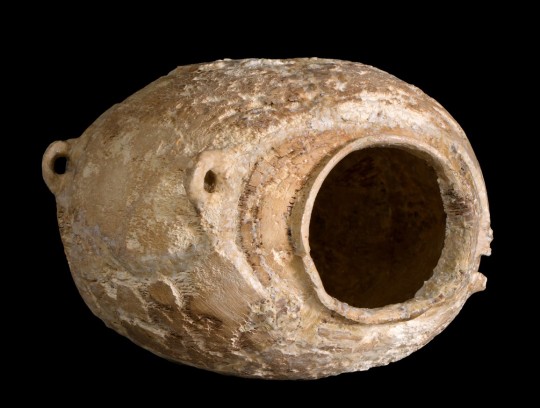
View On WordPress
#archaeology#archeologia#discoveries#English news#excavations#Israel#Israel Antiquities Authority#Israele
0 notes
Text
Eli Askozido, head of the Israel Antiquities Authority, published on his Instagram account a video showing the Israeli occupation army seizing Palestinian antiquities from inside Gaza.
The theft of antiquities is considered a war crime according to international law.
International conventions, such as the 1954 Hague Convention for the Protection of Cultural Property in the Event of Armed Conflict (Article 4), and its First Protocol, prohibit the seizure of antiquities during conflicts. Furthermore, the illicit trade of cultural properties, including antiquities, is a crime under the 1970 UNESCO convention on the Measures to be taken to Prevent the Import, Export, and Transfer of ownership of Cultural Property. Additionally, the seizure and destruction of antiquities are considered a war crime under Article 8 of the 1998 rome Statute of the International Criminal Court.
These laws emphasize the protection of cultural heritage and reinforce international criminal responsibility for those who violate these rules.
نشر إيلي أسكوزيدو رئيس سلطة الآثار الإسرائيلية على حسابه على انستجرام فيديو يظهر قيام جيش الاحتلال الإسرائيلي بالاستيلاء على تحف فلسطينية من داخل غزة.
تعد سرقة الآثار من جرائم الحرب وفقًا للقانون الدولي.
تحظر الاتفاقيات الدولية، مثل اتفاقية لاهاي لعام 1954 لحماية
الممتلكات الثقافية في حالة النزاع المسلح (المادة (4)، والبروتوكول الأول الملحق بها الاستيلاء على الآثار خلال النزاعات. كما يُعتبر الاتجار غير المشروع بالأملاك الثقافية، بما في ذلك الآثار، جريمة بموجب اتفاقية اليونسكو لعام 1970 بشأن التدابير الواجب اتخاذها لمنع استيراد وتصدير ونقل الملكية غير المشروع للممتلكات الثقافية. بالإضافة إلى ذلك، يُعد الاستيلاء على الآثار وتدميرها جريمة حرب بموجب المادة 8 من نظام روما الأساسي للمحكمة الجنائية الدولية لعام 1998. هذه القوانين تؤكد على حماية التراث الثقافي وتعزز المسؤولية الجنائية الدولية لمنتهكي هذه القواعد.
#israel is a terrorist state#israeli war crimes#gaza#israel is committing war crimes#palestine#free palestine#i stand with palestine#free gaza#jerusalem#فلسطين#israel
115 notes
·
View notes
Text
Fifty years ago, a stalactite with an incomplete inscription in ink, written in ancient Hebrew characteristic of the First Temple period, was found in a small cave very high on the cliffs over the Dead Sea, north of the Ein Gedi oasis. Now in the present day, four extremely well-preserved Roman swords have been found in the same cave by researchers revisiting it to further study the inscription.
The cache of ancient weaponry had been shoved into a deep crevice about 1,900 years ago, the Israel Antiquities Authority announced on Wednesday. Such blades were standard issue to Roman soldiers and were most likely somehow obtained by the Judean rebels and hidden in the cave for later use, the researchers suggest.

180 notes
·
View notes